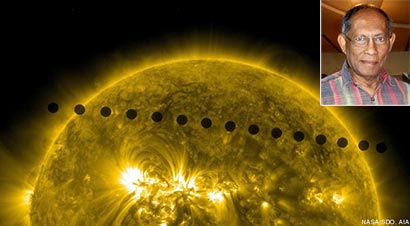CHANDRA WICKRAMASINGHE SAYS VENUSIAN LIFE CAME TO EARTH DURING THE TRANSIT
Posted on June 8th, 2012
By Walter Jayawardhana
During the June 5 Venus transit with earth biological material living on top layers of the cloud shrouded Venus would have reached earth said Professor Chandra Wickramasinghe of the Buckingham Center for Astro Biology. ƒÆ’-¡ƒ”š‚
Professor Chandra Wickramasinghe told this corresponent, ƒÆ’‚¢ƒ¢-¡‚¬ƒ…-The solar wind (a wind of charged energetic particles from the Sun) stretches out the atmosphere of Venus and drives bacterial particles away from the planet. ƒÆ’-¡ƒ”š‚ At the 5/6 June transit the Earth was exactly in the firing line.ƒÆ’‚¢ƒ¢-¡‚¬ƒ”š‚
ƒÆ’-¡ƒ”š‚ The Astrobiology Center said The possibility of specialised microorganisms inhabiting the yellow-tinged clouds of Venus has been under serious discussion since the 1980ƒÆ’‚¢ƒ¢-¡‚¬ƒ¢-¾‚¢s when the earliest Venera space missions began to explore the planet.ƒÆ’-¡ƒ”š‚ Now, the serious prospect of a Venusian aerobiology ƒÆ’‚¢ƒ¢-¡‚¬ƒ¢¢”š¬…” similar to the aerobiology and microbes that inhabit the EarthƒÆ’‚¢ƒ¢-¡‚¬ƒ¢-¾‚¢s clouds ƒÆ’‚¢ƒ¢-¡‚¬ƒ¢¢”š¬…” seems to be more secure.ƒÆ’-¡ƒ”š‚ In this context it becomes relevant to explore the possibility that transits of Venus, such as happened on 5 June, may offer scope for transfers of microbial life from Venus to Earth.
ƒÆ’-¡ƒ”š‚ Wickramasinghe said, ƒÆ’‚¢ƒ¢-¡‚¬ƒ…-We estimate that at the very least a billion billion bacteria and a billion billion billion viruses could have reached Earth on this day.ƒÆ’‚¢ƒ¢-¡‚¬ƒ”š‚
ƒÆ’-¡ƒ”š‚ Professor Wickramasinghe further said, ƒÆ’‚¢ƒ¢-¡‚¬ƒ…-“All the evidence points to the clouds of Venus being likely homes for microbial life. ƒÆ’-¡ƒ”š‚ Of this there is now little question. ƒÆ’-¡ƒ”š‚ The question
as to whether our neighbouring planet could occasionally infect our planet depends on whether there are routes for transfer from the clouds of Venus to Earth. ƒÆ’-¡ƒ”š‚ Together with Dr. Janaki Wickramasinghe I examined this matter in 2008 and again this year. ƒÆ’-¡ƒ”š‚ We came to the
conclusion that such transfers can occur during transits of Venus such as the one we saw on 5/6 June this year.ƒÆ’‚¢ƒ¢-¡‚¬ƒ”š‚ ƒÆ’-¡ƒ”š‚
ƒÆ’-¡ƒ”š‚ The Buckingham University Astrobiological Center said in a press release, ƒÆ’‚¢ƒ¢-¡‚¬ƒ…-Prof. Chandra Wickramasinghe and Dr. Janaki Wickramasinghe of the Buckingham Centre for Astrobiology published the case for such viable transfers in 2008 (Astrophys.Sp.Sci, 317, , pp. 133-137; http://adsabs.harvard.edu/abs/2008Ap%26SS.317..133W) and, now, in the Journal of Cosmology in relation to the most recent transit.ƒÆ’-¡ƒ”š‚ The case for such a transfer is based on investigations of the effect of the solar wind on the atmosphere of Venus and on the actual detections of charged particles from Venus near the Earth.ƒÆ’‚¢ƒ¢-¡‚¬ƒ”š‚
ƒÆ’-¡ƒ”š‚ Wickramasinghe further told this correspondent, ƒÆ’‚¢ƒ¢-¡‚¬ƒ…-This biological connection between Venus and Earth is of course not new. ƒÆ’-¡ƒ”š‚ Transfers of genes that would have occurred a few days ago must have happened at every transit for countless ages. Earth and the Goddess of love are therefore genetically related – neighbouring planets and biological siblings! ƒÆ’-¡ƒ”š‚ “

June 8th, 2012 at 6:13 pm
Will there be any evidence to prove because of virus and bacteria reaching the earth more people getting cold, flu and possibly allergies after the Venus transit ?
June 8th, 2012 at 10:26 pm
Planets nearer the sun tend toward an atmosphere predominantly of carbon dioxide gas with some carbon monoxide and traces of oxygen and ozone. These are produced when sunlight dissociates
carbon dioxide to CO and 0 and water to H and O; although the details of some processes are not entirely clear, H2, O 2 and O 3 are formed by recombination. Since photodissociation occurs only at the outer reaches the bulk of the atmosphere is just carbon dioxide. If one assumes that similar initial conditions prevailed during the origin of Venus, Earth and Mars (with C/H ratios characteristic of ehondritic meteorites), Venus, over its history, would have lost an ocean’s worth of water and is further advanced to a final abiological equilibrium than the Earth. No planet on which the sun shines can ever be in thermodynamic equilibrium. The equilibrium of a lifeless surface and none is left to sustain the production of oxygen. As a consequence of the return to relatively more reducing conditions, high temperature and acidity
which make the nitrate ion unstable on the Venus surface, nitrate there may have again reverted to N~. It is possible that the photoproduced oxygen of Venus has gone to oxidize the surface rocks which may well have dissolved in the superheated steam. At temperatures greater than 350°C and pressures above 50 atmospheres, superheated steam dissolves aluminosilicare
rocks. If this has been the case, Venus may turn out to have been melted to considerable
depths and may harbor crystalline oxidized gem minerals in quantity. As the sun remorselessly continues to increaseits output of energy, loss of hydrogen, utilization of surface oxygen for the oxidationof rocks, and thus a trend toward hot acid conditions would be expected to
follow on a lifeless Earth and later on Mars. At no stage of the evolution of an abiotic planet would more than mere traces of atmospheric oxygen be expected and certainly with alkaline oceans present N: and 0: would not coexist. From astronomy, meteorology, physics, and equilibrium chemsitry, it is doubtful that we could have predicted the present environmental conditions on the earth. Given only these sciences, something is lacking in the understanding of the atmospheric history of our anomalous planet. The most conspicuous difference on the
earth relative to the other terrestrial planets is the ubiquitous scum of the planet (and mostly lying within a few meters of the air, rock, water interface), namely the biota. Presumably it is this living system that is responsible for the phenomenon called Gaia which is a complex entity involving the earth’s atmosphere, biosphere, oceans and soil.